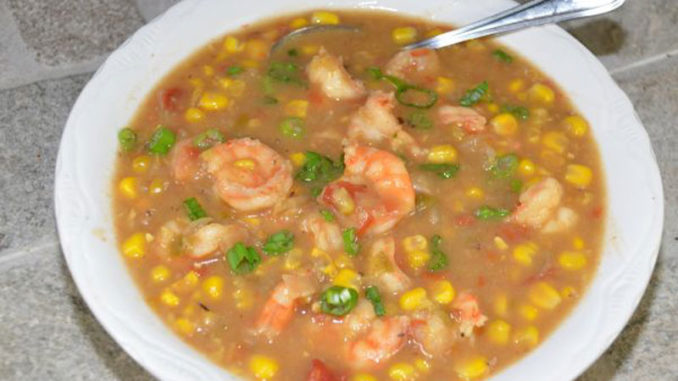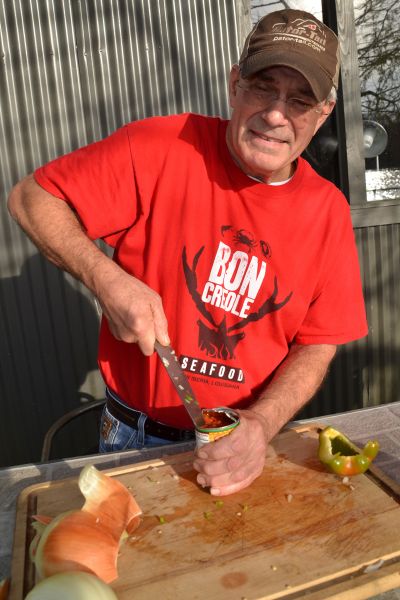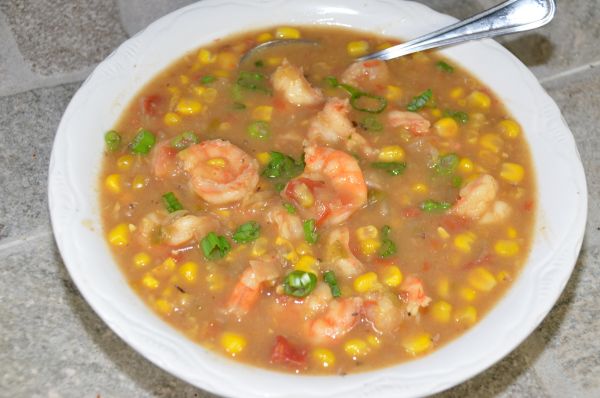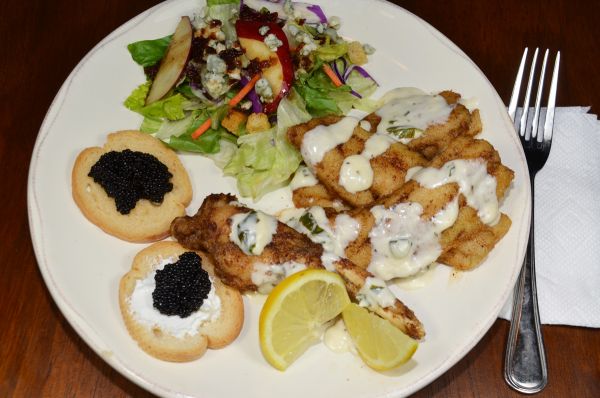
“Why don’t I bring Grandpa to the camp to cook the night before we fish?” volunteered the well-mannered young man.
He only had to offer once. His grandpa happened to be Randy Montegut, the owner (with his wife Julie) of the near-legendary New Iberia cult food restaurant Bon Creole Seafood, as well as one of the largest producers of Louisiana’s true seafood gem — bowfin (aka choupique) caviar.
I was fired up.
And Glenda was going to miss this trip. Too bad!
At 64, Randy Montegut has spent most of his adult life in the seafood industry. A degreed fisheries biologist, he left the security of a job at LSU to open a crawfish peeling plant named Bon Creole in Loreauville in 1982.
For more than 10 years, he hauled crawfish to New Orleans markets, and peeled and sold crawfish tail meat. He became deeply involved in the Swedish crawfish bubble. Swedes, it turned out, love crawfish as much as do Cajuns.
“Swedish crawfish are cooked with dill crowns, a little sugar and salt,” Randy explained. “The importers would bring their own dill to us. Ours wasn’t good enough.
“They have an open season from August through November. It is a festive time. The eat crawfish, and drink beer and vodka. The crawfish are eaten with ritual: They break the head and suck, lick and eat everything out of the head; they check the legs and body shell, and take all the meat out of the claws.”

Imported diseases had wiped out native Swedish crawfish and they had to turn elsewhere, wanting to buy only the largest crawfish — 10 per pound or larger.
For seven or eight years, business boomed. Then the Swedes found they could get the same crawfish a lot cheaper from China.
Seeking to diversify his business, Randy began processing choupique caviar, buying a small, nondescript cinder-block building on St. Peter Street in New Iberia for that purpose.
But Randy had another idea for the place — a restaurant.
“I had always wanted to do an overstuffed po-boy shop,” he said. “When I supplied crawfish to restaurants, the people who owed me the least money were po-boy and boiled seafood shops. The ones that stuck me with losses were fine-dining restaurants.
“I started with lunch only, five days a week. I served po-boys and plate lunches. The first day I took in $32. I gave everybody I knew personally their food free the first 2 days. The second day I took in $20.
“The next step was opening in evenings — then Saturdays. Finally, we added Sundays in the Cajun tradition of Sunday barbecues. Our daughter Renee put herself through school on the barbecues.”
During the whole time, Randy had two crawfish boiling trailers and did on-site catering. Presently, they do barbecue, steak, fried fish and jambalaya on-site, as well as pick-up catering.
And he still does choupique caviar processing.
Bon Creole Seafood has no readable sign. The building has no windows and is entirely painted in a faded, bleached, almost imperceptible swamp mural.
It is amazing — a world class seafood joint.
“Why paint a sign? I’m so busy I can’t do any more,” Randy said with a crooked grin. “When you don’t have a sign, they look for you harder.”
They are most famous for their shrimp po-boys, but are now selling the heck out of gumbo, as well.
“My next business will be a gumbo business,” he laughed.
For both of these recipes, Randy uses Bon Creole Seasoning, which is mixed and sold at his restaurant. If this is unavailable, he suggests using the Creole or Cajun seasoning or your choice.
Shrimp and Corn Soup
This dish was originally made using river shrimp, commonly cooked within the River Parishes, where Randy grew up. He calls them, “the best thing ever made.”
This recipe was originally his mother, Margaret’s recipe.
“I grew up eating it,” Randy said. “Because saltwater shrimp are not as flavorful as river shrimp, we save their shells to make a stock for the soup. We make this soup in the restaurant.”

Randy noted small shrimp best imitate his mother’s original recipe because river shrimp are very small.
He also added that, although 1 quart of water does not seem like enough liquid to boil the shrimp shells in, it is best not to use too much water or it may dilute the taste of the stock. Add more water to the soup during cooking as needed to keep the soup from becoming too thick.
INGREDIENTS:
- 2 1/2 lb. small to medium headless shrimp
- 3 qt. water, divided
- 2 medium onions, chopped
- 1 medium bell pepper, chopped
- 1 10-oz. can Rotel Original diced tomatoes and green chilies
- 1/3 cup canola oil
- 1/3 cup flour
- 1 16-oz. bag frozen corn
- 1 15-oz can cream style corn
- Creole seasoning to taste
PREPARATION:
Peel shrimp, reserving the shells, and set aside in refrigerator. Add the shrimp shells and water to a pot and boil 15 minutes to make a stock. Drain, reserve the liquid and discard the shells. Add the onions, bell peppers, and Rotel tomatoes to the stock. When the mixture comes to a boil, reduce the heat to simmer. Make a peanut butter-colored roux with the canola oil and flour, and add it to the stock. Add 2 quarts of water and simmer for 1 ½ hours. Add frozen corn, cream-style corn and shrimp. Season to taste with Creole seasoning. Simmer 10 minutes or until soup has the desired consistency. Serves 6-8.
Cocaine Sac-a-Lait & Frog legs
“Frying seafood this way is more addictive than cocaine,” Randy said with a mischievous grin. “I get tired of plain fried fish, so I do this a lot. It’s good with trout and great with redfish. I really like cooking in butter because I like the butter taste, although the fish won’t be as crunchy as when cooked in oil.
“I like basil, too. I use basil in almost all of my cream sauces in the restaurant.”
 The cream sauce really sets off the fried seafood. An option Randy often uses is substituting corn flake crumbs for the flour; these may be purchased by the box or made at home.
The cream sauce really sets off the fried seafood. An option Randy often uses is substituting corn flake crumbs for the flour; these may be purchased by the box or made at home.
Randy served this dish accompanied by his bowfin caviar on toasted bread rounds to add a touch of elegance to what was delicious camp cooking.
INGREDIENTS:
- 2 lb. butter, divided
- 1 pt. heavy cream
- 1 tbsp. fresh basil, minced
- 1/4 cup milk
- 2 tbsp. corn starch
- Juice of 1 lemon
- 1 tsp. finely chopped green onions
- 1 tsp. finely chopped parsley
- Creole seasoning
- 1/4 cup Parmesan cheese
- 2 lb. fish fillets
- 8 frog legs
- 2 cups all-purpose flour
PREPARATION:
Melt 1 lb. butter in a saucepan. Add cream and stir while heating. Add basil and simmer over medium heat for 5 minutes. Mix milk and corn starch, and set aside. Add lemon juice to the cream sauce and heat 5 more minutes. Add parsley, green onions and Creole seasoning to taste. While simmering cream sauce over low heat, stir corn starch mixture to re-suspend it and add a little at a time to the sauce, stirring constantly, until it reaches the desired consistency. Add Parmesan cheese and stir to melt. Turn heat off, cover, and set the sauce aside. Wash fillets and 8 frog legs. Melt the second pound of butter in a large frying pan. In a large bowl, add flour and Creole seasoning to taste. Roll the fillets and frog legs in the flour to lightly dust them and fry in butter over medium heat until they are done. Drizzle the cream sauce over the fish and frog legs. Serves 4.


